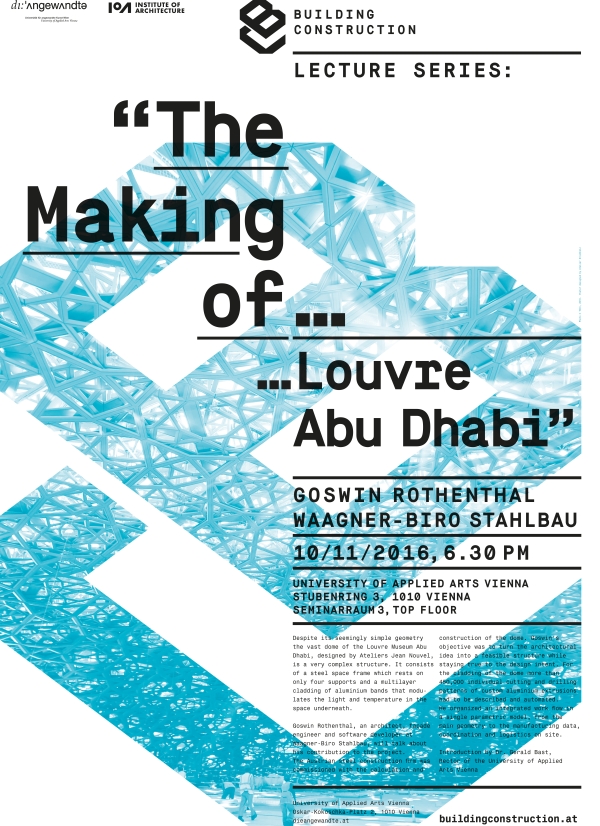The Making of: Louvre Abu Dhabi
Architects: Ateliers Jean Nouvel
This is a new lecture series that delves into the planning and construction processes of outstanding
architecture and looks at the topic from a technical point of view.
Introduction by Gerald Bast, president of the University
of Applied Arts Vienna
It provides a forum for experts who are – often little-noticed by the
architecture discourse – working behind the scenes but play a key role for the implementation of innovative architecture.
While the _making _of cinema blockbusters is well established as a film genre of its own, one hardly learns anything
about the genesis of great buildings. Usually in lectures about architecture only the beginning and the end of the design
and construction processes are presented: the key design ideas and the completed, impeccably photographed building. In the
lecture series _The Making of _special attention is being paid to the intermediate process. It addresses the challenges of
architecture production, trials and errors, research and technical progress.
The series will cover two lectures
per semester on average.
Vortrag The Making of Louvre Abu Dhabi
Architects: Ateliers
Jean Nouvel
Despite its seemingly simple geometry the vast dome of the Louvre Museum Abu Dhabi is a very complex
structure. It consists of a steel space frame which rests on only four supports and thus creates the impression of hovering
weightlessly above some irregularly arranged white cubes. A multilayer cladding of aluminium bands masks the dome’s steel
structure and modulates the light and temperature conditions of the space underneath. Jean Nouvel’s purpose was to create
a ‘rain of light’ as he called it, reminiscent of Mashrabiya and the specific atmosphere of Arabian souks. Büro Happold developed
the structural concept of the steel space frame, the Austrian steel construction firm Waagner-Biro Stahlbau AG was commissioned
with the calculation and construction of the steel dome.
GOSWIN ROTHENTHAL, an architect, façade engineer and software
developer at Waagner-Biro will talk about his contribution to the project. After having worked on extraordinary architecture
at Zaha Hadid for six years he wanted to know how a specialist contractor actually deals with complex projects, so he joined
Waagner-Biro Stahlbau. His objective was to turn the architectural idea into a feasible structure while staying true to the
design intent. For the cladding of the dome more than
450,000 individual cutting and drilling patterns of custom aluminum
extrusions had to be described and automated. He organized an integrated work flow in a single parametric model, from the
main geometry to the manufacturing data, coordination and logistics on site.




